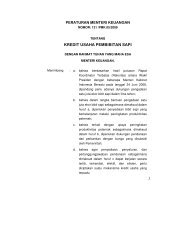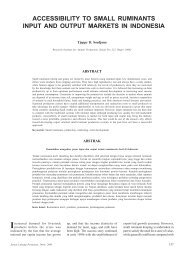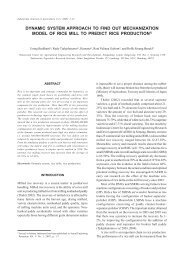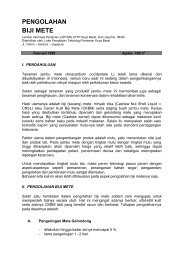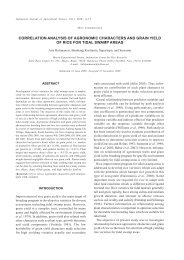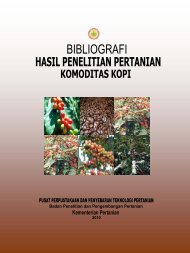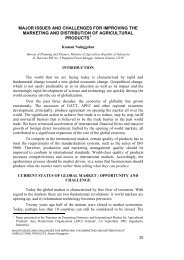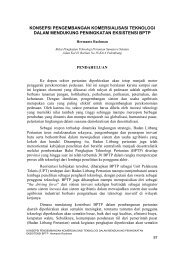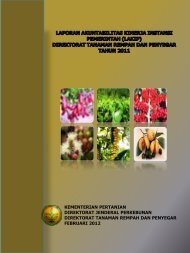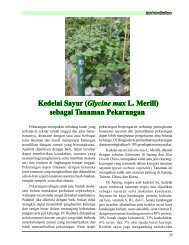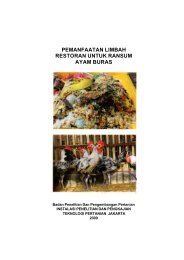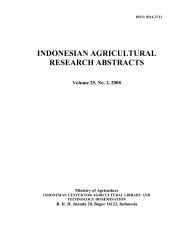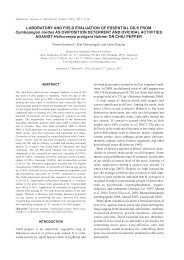Page 4Vol. 01 No. 1 February 2007d. To formulate policy recommendation related to modalities ondomestic supports, export subsidies, and tariff cuts without anadverse/negative impacts to the agricultural development andlivelihoods of the farmers and society as a whole.Outstanding Results and Policy ImplicationsThe level of domestic support of the Developed Countries (DDC)such as the US, the EU and Japan is in fact higher than those ofthe Developing Countries (DGC) such as Indonesia and the G-33.Soybean and other oilseeds are among the commodities enjoyinga high domestic support in the DDC. The US and Japan pertaintheir domestic supports to their paddy/rice-processed-rice andother cereal grains, while the EU give domestic support to itsplant-based fibers (cotton) commodity. Meanwhile, unlike theDDC countries, Indonesia and G-33 countries do not give highsubsidies/domestic support to their agricultural commodities.Among commodities that are getting the domestic supports arepaddy/rice, wheat, oilseeds, and plant-based fibers.The local government in Indonesia has not been systematicallynoted, calculated and recorded their own and local programs tosupport their agricultural sector, such as replanting, marketingsupport,extension, irigation-maintaining-suppport, into theircalculation of total domestic support. Nevertheless, those totaldomestic support calculations are needed to get the exactnumber of domestic support of the country. Among threecategories in the AoA-WTO round of talks (AMS, Green Box, BlueBox), only the Green Boxmeasurement that hadbeen implemented by thegovernment to increase thedevelopment of theagricultural sector. Thesupport is mainly come inthe form of funds transferfrom the centralgovernment as “dekonsentrasi funds”. This system ofdependency are happening due to the limited funds faced by thelocal government. Therefore, for Indonesia, the position as theDGC countries and member of the WTO with regard to thenotification of its domestic support in AoA, is to :(1) support andmaintain the de minimis level for the DGC countries, and (2)increase its domestic support as categorized in the Green Box,through the increasing of the “dekonsentrasi” transfer funds fromthe central government to the local government.Related to the G-20, the US, the EU, and the Hong KongProposals, on the scenario of domestic support cuts, Indonesiawill be facing the increasing prices of all commodities. Thehighest increased will be on the price ofland (1 percent) and the price ofoilseeds/soybean (2 percent).Indonesia’s volume of import of allcommodities analyzed will be decreased.The highest decreased is on theoilseeds/soybean of -6 to -9 percent. Allother commodities’ prices analyzed aredecreasing less than 1 percent, with theexception of Hong Kong Round’Proposal, for commodities paddy/riceand processed-rice, other cereal grains,vegetable oils and fats, and oilseeds.Total domestic demand on allcommodities will also be decreased, withthe highest decreased is on the demand of oilseeds/soybean at -0,4 to -0,5 percent. The positive impact on Indonesia is on theincreasing demand of the local/ domestic products/commoditiesto substitute the imported ones. It is shown on the increasingdemand of cereals, plant-based fibers, and raw milk-dairyproducts. Meanwhile the positive impact is shown on theimported-demand of horticulture products, animal products, andother crops. The overall impact of the domestic cut’ scenarios onthe Indonesia’ output of rice production, other cereals production(maize, soybean) andplant-based fibersproduction, will increaseat positive 0.02 to 5percent; whereas onwheat, horticulture,sugar and meat-animalproducts,willexperienced adecreasing rate.Therefore, the potentialrate of use of the Indonesia’s resources (either land,labour/employment or other natural resources) allocation onthose commodities are increasing, with the highest rate onoilseeds/soybean of more than 3 to 5 percents. The negative rateis on the commodity wheat due to incompatibility of the tropicalclimate of Indonesia. Other impact observed is on the land-basedresource allocation for paddy/rice, sugar and cattle. In the nearfuture, land use for those commodities will face consequences onthe land availability.The domestic support cut scenarios will have an effect on theGDP of each country, whether classifies as the DevelopedCountries (the US, the EU, Japan, Korea, Australia-New Zealand,etc.) or the Developing Countries-DGC (Indonesia and G33). Theimpact to the national GDP is high and positive for the DevelopedCountries (DDC) such as the US, the EU and others. ForIndonesia, an insignificant and low negative rate (- 0.003) willaffect its GDP. Indonesia’ welfare will also decreased around 18to 22 million $US.Export subsidies of the DDC are higher than the DGC, and theEU dominates the high. Among those commodities that arehaving high subsidies of the EU countries are paddy/riceprocessedrice, wheat, other cereals/grains (maize), sugar,livestock products-cattle. Indonesia and G-33 do not have a highexport subsidies on those commodities, and G-33 countries areonly subsidizing their sugar, vegetable oils and fats, andprocessed food products with low rate.Related to the G-20, the US, the EU, and the HongkongProposals, on the scenario of domestic support cuts shows thatIndonesia will experience the increasing prices of allcommodities. The highest increase of price will be on land (3percent ), wheat (5 percent), rice/paddy (1 percent), maize (2percent), soybean (1 percent), plant-based fibers (1 percent) <strong>dan</strong>cattle (1 percent). Meanwhile the impact of export subsidy cut willdecrease the Indonesia’ import volumes of all commodities, withthe exception on wheat, maize, and other crops. The highestdecreased rate will be faced by sugar,cattle, and raw milk-dairy products at therate from 7 to 23 percent (100%scenario). Other impact detected in thecut scenario is the decreasing rate of landavailability for commodities such aspaddy/rice and plant-based fibers. Itshould be interpreted and seen as therewill be land conversion for those twocommodities.The positive and high impact on the GDPwill be high and be significant only to theDDC countries, such as the EU.Nevertheless, for Indonesia, the decreaseon its GDP is relatively small (- 0,005 to -0,009 percent). Meanwhile, the Indonesian welfare will decreaseat the amount of US$ 68-135 millions.On the assessment of the G-20, the US, the EU, and the HongKong Proposals and carefully looking on each scheme of the tariffcuts, for the G-33 countries: (1) G-20 Proposal or the EUProposals gives relatively even tariff cuts on each band with theexception of the 4th band; (2) ACP Proposal made all tariff cutsemerged in a conical form, with majority cut at the first
Vol. 01 No. 1 February 2007Page 5band/bottom band and small cut at the4th/upper band, (3) Australia , the US, andthe New Zealand tier/band Proposals comein the form of the majority have to be emergein the 2nd and 4th band/tier, whilst theminority or small cuts are in the 3rd and 1stbands/tiers. For Indonesia: (1) the G-20 , theEU, and Australia Proposals willclustered/grouped the major of tariff cut inthe 2nd band/tier, smaller cuts in the 4thband/tier, and smallest or minor cut in the 1stand 3rd band/tier; (2) the ACP Proposal gives almost 90%configurated tariff at the 1st band/tier, with decreasing number ofcuts on subsequently tier/band; (3) the New Zealand Proposalgrouped or clustered the majority of tariffs on the 2nd band/tier(almost 87%), and subsequently conically to the upperbands/tiers. The G-20 or the EU Proposalsspread the tariffs all over the bands evenly,while the Australia-the US- the New Zealand-Proposals distribute the tariffs only at the 2n<strong>dan</strong>d 4th band/tier. Meanwhile ACP CountriesProposal group the tariff cut pyramidally. ForIndonesia and G-33, the Australia and the USProposals will caused drastically cutting thetariffs compare to the EU, the G-20 and theACP Proposals. The New Zealand Proposalshow a lower rate in tariff cut. However theACP Proposal is showing the lowest and very moderate cutamong all Proposals.Correspondence: Budiman Hutabarat(budihutabarat@yahoo.com)Recent Policy DevelopmentINCREASING RICE PRODUCTION BY TWOMILLION TONS IN 2007: OPPORTUNITY ANDCHALLENGEJanuary 2007 mark theissuance of the governmentplan to increase two milliontons of rice during 2007.This endeavor was raised toface a great challenge of ricedeficit to feed the country, letthe additional productiontarget provided locally. Theproduction centers havebeen prepared to participate in the program throughintensification, extensification, the improvement of the farmingsystem, production gui<strong>dan</strong>ce, seed and fertilizers subsidy,production capital, etc.Total production of paddy in 2006 was 54.7 million tons and withthe target of production amounted to 58.4 miilion tons in 2007, theincreasing production of 3.3 million tons is expexted to provide 2million tons of rice. Four main activities to meet this target are:providing sufficient water for irrigation, using high quality of seed,applying balance fertilizers, reducing production losses. Theseactivities are guarded by various means and tools to ensure theright implementation of the program. The government will buyfarmer’s rice production using newly set up purchasingmechanism, decrease the dependency on rice import. Budgetallocated to achieve this target has been provided, amounted to8.7 trillion rupiahs to especially subsidize seed and bank interest,credit assurance, and cost for extension activities.There are 16 provinces included in the program, i.e., Aceh, NorthSumatera, West Sumatera, South Sumatera, Lampung, WestJava, Central Java, East Java, DI Yogyakarta, Banten, Bali, WestNusa Tenggara, West Kalimantan, South Kalimantan, SouthSulawesi, and Gorontalo. Budget allocated for credit has beenprepared by Ministry of Agriculture, i.e., food security credit(KKP/Rp. 3.87 trillion), agricultural budget service scheme(SP3/Rp.1 trillion), rural economic development (LUEP/Rp. 223billion), and agricultural investment credit (Rp. 500 billion) inaddition to 25% of down payment prepared to purchaseagroindustry industrial tools and machineries plus warehousecostscheme.This is an optimistic views to achieve the target, meanwhile thereare also pessimistic of some stakeholders of its failure, taking intoaccount the unpredicted climate condition. The anomaly ofclimate has forced the farmers to delay their seedling andplanting period adjusted to the beginning of rainy season. Theshrinkage of planted area and a high explosion of pest attackcould influence the production. Moreover, the prolong droughtpredicted in 2007 will also affect the production process.Understanding this condition, the focus of production is, therefore,given to seven provinces with target planted area are scatterednearby dams. SouthSumatra, Lampung,West Java, CentralJava, East Java, WestNusa Tenggara andSouth Sulawesi are theregion in which damsare available. About800 thousand ha of wetland or 1.6 million ha ofplanted area in 2007 isexpected to produce 3.26 million tons of paddy or 1.86 milliontons of rice (89.73% of the previous target). And for wateravailability at the dams, the government will provide artificial rain(February to April 2007) to fill in water at the dams for especiallyirrigation during the second planting season of 2007. Small andscattered piece of lands are also provided to keep water forcertain purposes during the drought planting season.Research ActivitiesNATIONAL SEMINAR ON AGRICULTURALDEVELOPMENT IN 2006 AND ITS PROSPECTIN 2007This seminar is organized by the ICASEPS as one of its activitiesto disseminate research results with specifically respond to thelatest stage of national agricultural development activities. Theobjectives aimed at the performance of agricultural developmentfrom the point of view of achievement indicators in 2006 and usethe findings as bases of formulation for operational steps tostrengthen agricultural development in 2007.The seminar was held on 20 December 2007 at the Bumikarsa-Bidakara Hotel in Jakarta and was officially opened with thekeynote speech by Dr. Achmad Suryana, the Director General ofthe Agency for Agricultural Research and Development. It wasattended by researchers, decision makers, agribusinesspractices, representatives from universities, state-ownedenterprises, and NGOs including the national farmers association(HKTI). All papers presented by the ICASEPS’ policy researcherswith critical discussions delivered by the university, professors,journalists, and senior researchers institutes.The topics covers macro indicators of the agriculturaldevelopment in 2006 and 2007, such as poverty alleviation,



